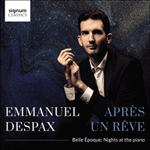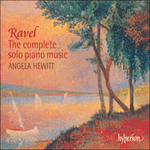Although Ricardo Viñes had arrived in Paris in 1887 as a boy knowing no French, he soon learnt large portions of French literature by heart and it was he who introduced Ravel to Aloysius Bertrand’s book of poems
Gaspard de la nuit, written between 1832 and 1836 and published in 1842. The poems appealed to Ravel’s love of fairytales and the supernatural, and to his taste for Edgar Allan Poe’s macabre stories. The spirit of Liszt also hovers over Ravel’s three pieces, in the brilliance of the writing and no less in its technical demands. The water nymph Ondine tries to lure the author down to be king in her underwater palace: beauty and danger are wonderfully combined in Ravel’s score, and to this end he asked that Ondine’s theme should not stand out but should be absorbed into the surrounding atmosphere. Likewise in ‘Le gibet’ the bell, ringing for the corpse of the hanged man glowing red in the setting sun, ‘does not dominate, it is, it tolls unwearyingly’. Sad to say, Viñes insisted on livening up the piece, and after the premiere on 9 January 1909 Ravel entrusted him with no more first performances. Scarbo, the malevolent dwarf, here one moment, gone the next, is the master of surprises: ‘How many times have I heard his laughter buzz in the shadows of my alcove, and his fingernails scratching on the silk curtains round my bed!’ Ravel admitted that he had wanted to write a piece more difficult than Balakirev’s
Islamey, but that ‘perhaps I let myself get carried away!’
from notes by Roger Nichols © 2011
Si Ricardo Viñes était arrivé à Paris en 1887 sans savoir un mot de français, il a vite appris par cœur de grands passages de littérature française et c’est lui qui a présenté à Ravel le livre de poèmes d’Aloysius Bertrand,
Gaspard de la nuit, écrit entre 1832 et 1836 et publié en 1842. Les poèmes ont plu à Ravel qui aimait tant les contes de fées et le surnaturel, ainsi que les histoires macabres d’Edgar Allan Poe. L’esprit de Liszt plane aussi sur les trois pièces de Ravel, dans l’éclat de l’écriture tout comme dans ses exigences techniques. La naïade Ondine tente d’attirer l’auteur dans son palais sous-marin pour qu’il en devienne roi: la beauté et le danger s’allient merveilleusement dans la partition de Ravel et, à cette fin, il a demandé que le thème d’Ondine ne ressorte pas mais soit absorbé dans l’atmosphère environnante. De même dans «Le gibet», la cloche qui sonne le glas du cadavre du pendu rougeoyant au coucher du soleil «ne domine pas, elle est, elle tinte inlassablement». C’est malheureux à dire, mais Viñes a insisté pour égayer la pièce, et après la création, le 9 janvier 1909, Ravel ne lui a plus confié de création. Scarbo, le nain malveillant, qui surgit et disparaît aussitôt, est le maître des surprises: «Que de fois j’ai entendu bourdonner son rire dans l’ombre de mon alcôve, et grincer son ongle sur la soie des courtines de mon lit!» Ravel a admis qu’il avait voulu composer une pièce plus difficile qu’
Islamey de Balakirev, mais «je m’y suis peut-être laissé prendre!».
extrait des notes rédigées par Roger Nichols © 2011
Français: Marie-Stella Pâris
Obwohl Ricardo Viñes 1887 als Junge in Paris ankam und kein Französisch sprach, lernte er bald die französische Literatur zu großen Teilen auswendig und durch ihn lernte Ravel Aloysius Bertrands Gedichtband
Gaspard de la nuit kennen, der zwischen 1832 und 1836 entstanden und 1842 veröffentlicht worden war. Ravel—der sich für Märchen und das Übernatürliche besonders interessierte und auch Edgar Allan Poes makabre Geschichten sehr mochte—sprachen diese Gedichte gleich an. Auch der Geist Liszts ist in den drei ravelschen Stücken zu spüren, sowohl in dem brillanten Kompositionsstil als auch in den technischen Anforderungen. Die Wassernymphe Ondine versucht, den Erzähler als König ihres Unterwasserpalasts herunterzulocken: Schönheit und Gefahr sind in Ravels Musik auf wunderbare Art miteinander kombiniert, weshalb er darum bat, dass Ondines Thema nicht hervortreten, sondern von der es umgebenen Atmosphäre absorbiert werden möge. Ebenso die Glocke in „Le gibet“, die für die Leiche des erhängten Manns läutet, die in dem Licht der untergehenden Sonne rot glüht—„sie dominiert nicht, sie ist, sie läutet unverdrossen“. Leider bestand Viñes darauf, das Stück zu beleben … und nach der Premiere am 9. Januar 1909 vertraute Ravel ihm keine weiteren Erstaufführungen mehr an. Scarbo, der boshafte Zwerg, jetzt hier, nun weg, ist der Meister der Überraschungen: „Wie oft habe ich sein Lachen in dem Schatten meines Alkoven dröhnen und seinen Fingernagel auf dem seidenen Vorhang meines Bettes kratzen gehört!“ Ravel gab zu, dass er ein schwierigeres Werk als Balakirews Islamey hatte komponieren wollen, doch dass er sich „vielleicht hatte hinreißen lassen!“
aus dem Begleittext von Roger Nichols © 2011
Deutsch: Viola Scheffel

 Après un rêve
Après un rêve Ravel: The Complete Solo Piano Music
Ravel: The Complete Solo Piano Music
